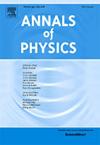Uncertainty relations for the triple components of the hydrogen atom
IF 3
3区 物理与天体物理
Q2 PHYSICS, MULTIDISCIPLINARY
引用次数: 0
Abstract
As one of the core principles of quantum mechanics, the uncertainty relation profoundly reveals the inherent non-commutativity of physical quantities in the microscopic world. It provides a theoretical foundation for the precision limits of quantum measurements and has significant applications in fields such as quantum information and precision spectroscopy. Traditional uncertainty relations primarily focus on the mutual constraints between two non-commuting observables. However, for complex quantum systems, uncertainty relations involving multiple physical quantities can more comprehensively characterize the cooperative effects of quantum fluctuations and offer new perspectives for optimizing the allocation of core quantum resources. The hydrogen atom is one of the few strictly solvable systems with hidden symmetries, and the study of its symmetries and conserved quantities has always been a central topic in theoretical physics. In this work, we take the hydrogen atom as the research object and derive the additive and multiplicative uncertainty relations for the three components of the orbital angular momentum, the three components of the quantum Runge–Lenz vector, and the three components of their arbitrary linear combination . The results show that, compared to the usual uncertainty relations involving only two components, the three-component uncertainty relations are related to a constant .
氢原子三组分的不确定关系
作为量子力学的核心原理之一,测不准关系深刻地揭示了微观世界中物理量固有的非交换性。它为量子测量的精度限制提供了理论基础,在量子信息和精密光谱学等领域有着重要的应用。传统的不确定性关系主要关注两个不可交换观测值之间的相互约束。而对于复杂量子系统,涉及多个物理量的不确定性关系可以更全面地表征量子涨落的协同效应,为核心量子资源的优化配置提供新的视角。氢原子是少数具有隐藏对称性的严格可解系统之一,其对称性和守恒量的研究一直是理论物理学的中心课题。本文以氢原子为研究对象,推导了轨道角动量的三个分量、量子龙格-伦茨矢量的三个分量以及它们的任意线性组合W→的三个分量的加性和乘性不确定性关系。结果表明,与通常只涉及两个分量的不确定关系相比,三分量的不确定关系与常数2/3有关。
本文章由计算机程序翻译,如有差异,请以英文原文为准。
求助全文
约1分钟内获得全文
求助全文
来源期刊

Annals of Physics
物理-物理:综合
CiteScore
5.30
自引率
3.30%
发文量
211
审稿时长
47 days
期刊介绍:
Annals of Physics presents original work in all areas of basic theoretic physics research. Ideas are developed and fully explored, and thorough treatment is given to first principles and ultimate applications. Annals of Physics emphasizes clarity and intelligibility in the articles it publishes, thus making them as accessible as possible. Readers familiar with recent developments in the field are provided with sufficient detail and background to follow the arguments and understand their significance.
The Editors of the journal cover all fields of theoretical physics. Articles published in the journal are typically longer than 20 pages.
 求助内容:
求助内容: 应助结果提醒方式:
应助结果提醒方式:


